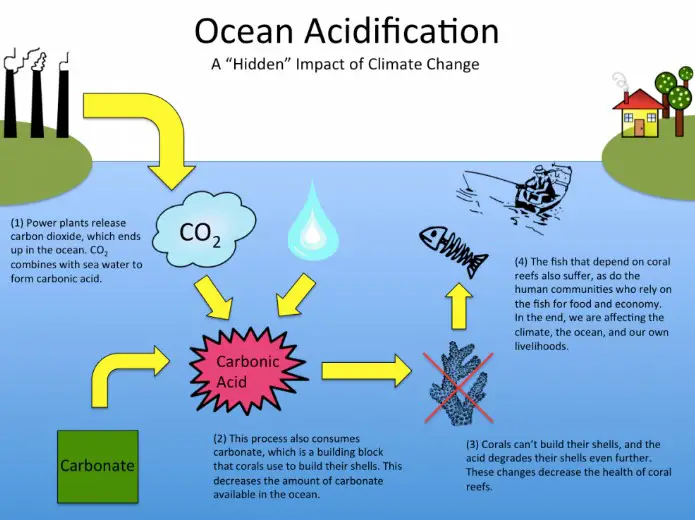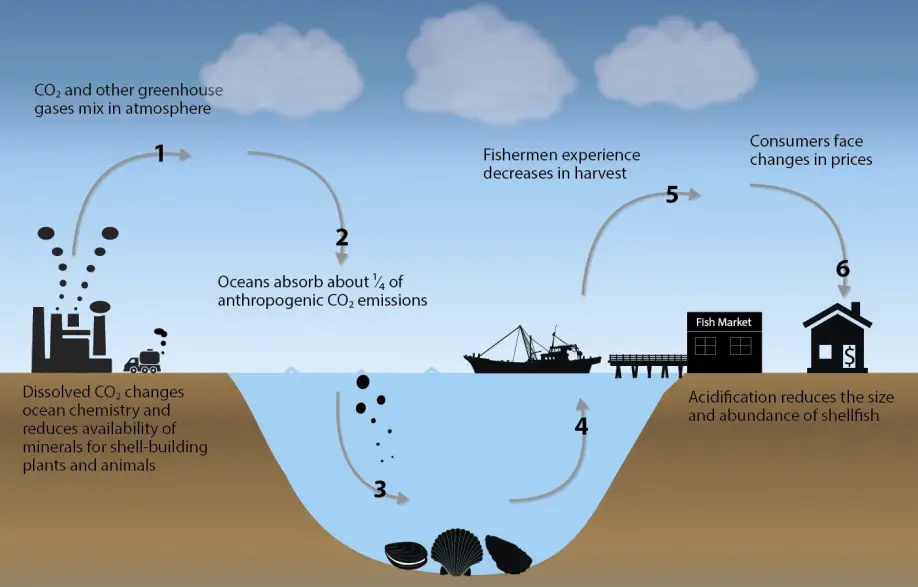Climate change encompasses a wide array of environmental issues, two of which stand prominently: ocean acidification and global warming. While often mentioned in the same breath due to their common root in human activities, these phenomena impact the Earth’s systems in distinctly different ways. Their understanding is crucial for devising strategies to mitigate the ongoing damage and to ensure the planet remains hospitable for future generations.
Ocean acidification refers to the decrease in the pH levels of the Earth’s oceans, primarily caused by the uptake of carbon dioxide (CO2) from the atmosphere. Global warming, on the other hand, is the increase in Earth’s average surface temperature, resulting from greenhouse gas emissions. Both pose significant threats to the stability of environmental and human systems, yet operate through different mechanisms with unique sets of consequences.
The complexity of these processes and their effects cannot be overstated. Ocean acidification jeopardizes marine ecosystems, particularly affecting calcifying organisms essential for maintaining the biodiversity of the oceans. Global warming leads to extreme weather conditions, melting polar ice caps, and rising sea levels, thereby altering habitats and increasing the vulnerability of both natural and human systems. Recognizing the distinction and interconnection between these two phenomena is key to addressing the broader challenge of climate change.

Ocean Acidification Explained
Definition and Causes
Ocean acidification is a decrease in the pH levels of the Earth’s oceans, primarily due to the absorption of carbon dioxide (CO2) from the atmosphere. It’s a direct consequence of increased CO2 emissions from human activities such as fossil fuel combustion, deforestation, and industrial processes. This phenomenon poses a significant threat to marine life and ecosystems, impacting the global carbon cycle and oceanic biodiversity.
Chemical Process Behind Acidification
The process begins when CO2 dissolves in seawater, forming carbonic acid (H2CO3), which subsequently dissociates into bicarbonate (HCO3-) and hydrogen ions (H+). The increase in hydrogen ions decreases pH levels, making the water more acidic. This shift in ocean chemistry can disrupt the balance of marine life, particularly affecting organisms that rely on calcium carbonate (CaCO3) for their shells and skeletons.
Effects on Marine Life
Ocean acidification has profound effects on a variety of marine species:
- Shell-forming organisms such as corals, mollusks, and some plankton are particularly vulnerable, as acidification reduces the availability of carbonate ions needed to form calcium carbonate structures.
- Fish and other marine species may experience altered behavior, growth rates, and reproductive patterns due to changes in water chemistry.
- Coral reefs, the backbone of marine biodiversity, face bleaching and degradation, affecting species that depend on them for food and habitat.
Global Impact
The global impact of ocean acidification extends beyond marine ecosystems:
- It threatens food security by affecting fishery yields.
- It disrupts local economies dependent on fishing and tourism.
- Acidification can alter the ocean’s ability to absorb CO2, potentially accelerating climate change.
Global Warming Overview
Definition and Causes
Global warming refers to the long-term increase in Earth’s average surface temperature. This phenomenon is largely attributed to human activities that release greenhouse gases (GHGs) into the atmosphere, such as CO2, methane (CH4), and nitrous oxide (N2O). The primary sources include burning fossil fuels, deforestation, and industrial processes.
Greenhouse Gases and Their Role
Greenhouse gases play a pivotal role in global warming by trapping heat in the Earth’s atmosphere. This “greenhouse effect” is a natural process necessary for life on Earth, but the excessive accumulation of GHGs enhances this effect, leading to a rise in global temperatures.
Impact on Climate and Weather Patterns
Global warming has significant impacts on climate and weather patterns:
- Increased temperatures lead to melting ice caps and glaciers, contributing to sea-level rise.
- Extreme weather events, such as hurricanes, droughts, and heatwaves, become more frequent and severe.
- Changes in precipitation patterns affect water availability and agriculture.
Effects on Ecosystems and Human Life
The consequences of global warming on ecosystems and human life are vast:
- Loss of biodiversity as species struggle to adapt to changing conditions.
- Health risks increase with the spread of diseases and heat-related illnesses.
- Economic impacts are felt across various sectors, including agriculture, insurance, and infrastructure.
Key Differences
Chemical vs. Thermal Changes
The fundamental difference between ocean acidification and global warming lies in their nature:
- Ocean acidification is a chemical change, involving a shift in the ocean’s pH balance due to CO2 absorption.
- Global warming is a thermal change, with rising temperatures caused by the enhanced greenhouse effect.
Causes and Contributing Factors
While both phenomena are driven by human activities, their primary causes differ:
- Ocean acidification is directly linked to CO2 emissions.
- Global warming results from a broader set of greenhouse gas emissions, including CO2, methane, and nitrous oxide.
Impact on Marine vs. Terrestrial Environments
- Ocean acidification predominantly affects marine environments, with profound impacts on ocean chemistry and marine life.
- Global warming impacts both terrestrial and aquatic ecosystems, altering climate patterns, weather events, and global temperatures.
Long-term Consequences
The long-term consequences of both phenomena highlight the urgency of addressing them:
- Ocean acidification could lead to the collapse of marine food webs and the loss of biodiversity.
- Global warming threatens to disrupt natural systems, leading to severe environmental, economic, and health impacts worldwide.

Interconnectedness
How Ocean Acidification and Global Warming Interact
Ocean acidification and global warming are not isolated phenomena but are closely interconnected, each exacerbating the impact of the other. The primary link between the two is carbon dioxide (CO2). Elevated levels of CO2 contribute to global warming by trapping heat in the atmosphere. At the same time, the oceans absorb CO2, leading to acidification. This dual role of CO2 creates a vicious cycle where global warming further increases the temperature of the ocean surface, potentially accelerating the rate of CO2 absorption and, consequently, acidification.
Compound Effects on the Environment
The compound effects of ocean acidification and global warming on the environment are profound. Coral reefs, for instance, are doubly impacted: global warming causes coral bleaching, while acidification weakens coral skeletons, diminishing their resilience. Similarly, marine species affected by changing ocean temperatures due to global warming may also struggle with the altered chemistry resulting from acidification, affecting their reproduction, growth, and survival rates.
Feedback Loops and Exacerbation
Feedback loops between ocean acidification and global warming can lead to the exacerbation of both conditions. For example, as ocean acidification diminishes the capacity of marine plants and corals to absorb CO2, more of this gas remains in the atmosphere, enhancing the greenhouse effect and further warming the planet. Additionally, melting ice caps and glaciers, a direct consequence of global warming, freshen ocean water, potentially altering ocean currents and the global distribution of heat and CO2, further influencing acidification and warming trends.
Addressing the Challenges
Mitigation Strategies for Ocean Acidification
To mitigate ocean acidification, efforts must focus on reducing CO2 emissions at the source. Strategies include:
- Transitioning to renewable energy sources such as wind, solar, and hydro to decrease reliance on fossil fuels.
- Enhancing carbon sequestration techniques, including reforestation and the development of artificial methods to capture and store CO2 from the atmosphere.
- Promoting sustainable fishing and marine conservation practices to preserve ecosystems that can help buffer against acidification effects.
Global Warming Prevention and Control Measures
Preventing and controlling global warming involves comprehensive strategies aimed at reducing greenhouse gas emissions and enhancing the Earth’s natural carbon sinks. Key measures include:
- Implementing energy efficiency in buildings, transportation, and industries.
- Encouraging low-carbon technologies and investing in research and development to find new solutions for reducing emissions.
- Adopting climate-smart agricultural practices to reduce methane and nitrous oxide emissions from farming activities.
The Role of International Cooperation and Policy
International cooperation and policy play critical roles in addressing both ocean acidification and global warming. Agreements such as the Paris Agreement aim to limit global temperature rise by setting emission reduction targets for countries. Effective action requires:
- Global coordination to ensure countries adhere to their emission reduction commitments.
- Financial and technological support for developing nations to transition to greener economies.
- Enforcement mechanisms to hold countries accountable for their environmental impacts.
Future Perspectives
Research and Technological Advancements
Ongoing research and technological advancements are crucial for understanding and mitigating the impacts of ocean acidification and global warming. Innovations in carbon capture and storage (CCS) technologies, renewable energy, and geoengineering are among the frontiers being explored. Additionally, monitoring and modeling efforts are essential for predicting future changes and guiding policy decisions.
Predictions for Marine and Terrestrial Environments
Predictions for marine and terrestrial environments under the influence of ocean acidification and global warming include:
- Increased temperature and acidity in oceans, leading to widespread impacts on marine ecosystems.
- Shifts in species distributions and loss of biodiversity, both in aquatic and terrestrial habitats.
- Altered precipitation patterns and more extreme weather events, affecting agriculture, water resources, and human settlements.
The Importance of Global Awareness and Action
Global awareness and action are paramount to addressing the challenges posed by ocean acidification and global warming. Public education and engagement can drive the demand for sustainable products and practices, influencing businesses and policymakers. Collective action at all levels, from individual choices to global policies, is necessary to safeguard the planet for future generations.
Frequently Asked Questions
How Does Ocean Acidification Affect Marine Life?
Ocean acidification primarily affects marine species that build shells or skeletons from calcium carbonate, such as corals, mollusks, and some plankton species. The increased acidity of the water hampers their ability to form these structures, compromising their survival and, by extension, the marine food web. This disruption has cascading effects on marine biodiversity, fisheries, and ecosystems globally.
Can Global Warming Be Reversed?
Reversing global warming requires drastic reductions in greenhouse gas emissions, alongside large-scale efforts to remove carbon from the atmosphere. Transitioning to renewable energy sources, reforestation, and innovative carbon capture technologies are among the strategies that can mitigate global warming. However, the reversal is a long-term process that necessitates global cooperation and sustained action.
What Are the Long-term Consequences of Ocean Acidification and Global Warming?
The long-term consequences include significant disruptions to ecosystems, loss of biodiversity, altered weather patterns, and a rise in sea levels, potentially leading to catastrophic effects on human and natural systems. Food security, water supply, health, and economic stability are all at risk, underscoring the need for urgent action to curb these trends.
How Can Individuals Contribute to Combating These Issues?
Individuals can contribute by reducing their carbon footprint through lifestyle changes such as using public transportation, conserving energy, and supporting sustainable practices and products. Advocacy for policies that reduce emissions and protect the environment is also crucial. Personal actions, while seemingly small, collectively make a significant impact.
Conclusion
Ocean acidification and global warming are two sides of the same coin, both stemming from human activity yet affecting the planet in uniquely harmful ways. Understanding their differences and interconnections is crucial for developing effective strategies to mitigate their effects. The urgency to act is underscored by the profound impacts these phenomena have on ecosystems, weather patterns, sea levels, and, ultimately, human survival.
The path forward requires a concerted effort from individuals, communities, and nations worldwide. By prioritizing sustainable practices, supporting clean energy, and advocating for strong environmental policies, we can mitigate the impact of these challenges. The responsibility to safeguard our planet for future generations lies with us, and the time to act is now.
